#aws s3 tutorial
Explore tagged Tumblr posts
Text
Amazon S3 Bucket Feature Tutorial Part2 | Explained S3 Bucket Features for Cloud Developer
Full Video Link Part1 - https://youtube.com/shorts/a5Hioj5AJOU Full Video Link Part2 - https://youtube.com/shorts/vkRdJBwhWjE Hi, a new #video on #aws #s3bucket #features #cloudstorage is published on #codeonedigest #youtube channel. @java #java #awsc
Amazon Simple Storage Service (Amazon S3) is an object storage service that offers industry-leading scalability, data availability, security, and performance. Customers of all sizes and industries can use Amazon S3 to store and protect any amount of data. Amazon S3 provides management features so that you can optimize, organize, and configure access to your data to meet your specific business,…

View On WordPress
#amazon s3 bucket features#amazon s3 features#amazon web services#aws#aws cloud#aws cloudtrail#aws cloudwatch#aws s3#aws s3 bucket#aws s3 bucket creation#aws s3 bucket features#aws s3 bucket tutorial#aws s3 classes#aws s3 features#aws s3 interview questions and answers#aws s3 monitoring#aws s3 tutorial#cloud computing#s3 consistency#s3 features#s3 inventory report#s3 storage lens#simple storage service (s3)#simple storage service features
0 notes
Text
0 notes
Video
youtube
Terraform on AWS - Remote State Storage and State Locking with AWS S3 an...
#youtube#🚀 Master Terraform Remote State Management on AWS with S3 and DynamoDB! 🚀 In this comprehensive tutorial we’ll explore how to configure T
0 notes
Video
youtube
Complete Hands-On Guide: Upload, Download, and Delete Files in Amazon S3 Using EC2 IAM Roles
Are you looking for a secure and efficient way to manage files in Amazon S3 using an EC2 instance? This step-by-step tutorial will teach you how to upload, download, and delete files in Amazon S3 using IAM roles for secure access. Say goodbye to hardcoding AWS credentials and embrace best practices for security and scalability.
What You'll Learn in This Video:
1. Understanding IAM Roles for EC2: - What are IAM roles? - Why should you use IAM roles instead of hardcoding access keys? - How to create and attach an IAM role with S3 permissions to your EC2 instance.
2. Configuring the EC2 Instance for S3 Access: - Launching an EC2 instance and attaching the IAM role. - Setting up the AWS CLI on your EC2 instance.
3. Uploading Files to S3: - Step-by-step commands to upload files to an S3 bucket. - Use cases for uploading files, such as backups or log storage.
4. Downloading Files from S3: - Retrieving objects stored in your S3 bucket using AWS CLI. - How to test and verify successful downloads.
5. Deleting Files in S3: - Securely deleting files from an S3 bucket. - Use cases like removing outdated logs or freeing up storage.
6. Best Practices for S3 Operations: - Using least privilege policies in IAM roles. - Encrypting files in transit and at rest. - Monitoring and logging using AWS CloudTrail and S3 access logs.
Why IAM Roles Are Essential for S3 Operations: - Secure Access: IAM roles provide temporary credentials, eliminating the risk of hardcoding secrets in your scripts. - Automation-Friendly: Simplify file operations for DevOps workflows and automation scripts. - Centralized Management: Control and modify permissions from a single IAM role without touching your instance.
Real-World Applications of This Tutorial: - Automating log uploads from EC2 to S3 for centralized storage. - Downloading data files or software packages hosted in S3 for application use. - Removing outdated or unnecessary files to optimize your S3 bucket storage.
AWS Services and Tools Covered in This Tutorial: - Amazon S3: Scalable object storage for uploading, downloading, and deleting files. - Amazon EC2: Virtual servers in the cloud for running scripts and applications. - AWS IAM Roles: Secure and temporary permissions for accessing S3. - AWS CLI: Command-line tool for managing AWS services.
Hands-On Process: 1. Step 1: Create an S3 Bucket - Navigate to the S3 console and create a new bucket with a unique name. - Configure bucket permissions for private or public access as needed.
2. Step 2: Configure IAM Role - Create an IAM role with an S3 access policy. - Attach the role to your EC2 instance to avoid hardcoding credentials.
3. Step 3: Launch and Connect to an EC2 Instance - Launch an EC2 instance with the IAM role attached. - Connect to the instance using SSH.
4. Step 4: Install AWS CLI and Configure - Install AWS CLI on the EC2 instance if not pre-installed. - Verify access by running `aws s3 ls` to list available buckets.
5. Step 5: Perform File Operations - Upload files: Use `aws s3 cp` to upload a file from EC2 to S3. - Download files: Use `aws s3 cp` to download files from S3 to EC2. - Delete files: Use `aws s3 rm` to delete a file from the S3 bucket.
6. Step 6: Cleanup - Delete test files and terminate resources to avoid unnecessary charges.
Why Watch This Video? This tutorial is designed for AWS beginners and cloud engineers who want to master secure file management in the AWS cloud. Whether you're automating tasks, integrating EC2 and S3, or simply learning the basics, this guide has everything you need to get started.
Don’t forget to like, share, and subscribe to the channel for more AWS hands-on guides, cloud engineering tips, and DevOps tutorials.
#youtube#aws iamiam role awsawsaws permissionaws iam rolesaws cloudaws s3identity & access managementaws iam policyDownloadand Delete Files in Amazon#IAMrole#AWS#cloudolus#S3#EC2
2 notes
·
View notes
Text
Journey to AWS Proficiency: Unveiling Core Services and Certification Paths
Amazon Web Services, often referred to as AWS, stands at the forefront of cloud technology and has revolutionized the way businesses and individuals leverage the power of the cloud. This blog serves as your comprehensive guide to understanding AWS, exploring its core services, and learning how to master this dynamic platform. From the fundamentals of cloud computing to the hands-on experience of AWS services, we'll cover it all. Additionally, we'll discuss the role of education and training, specifically highlighting the value of ACTE Technologies in nurturing your AWS skills, concluding with a mention of their AWS courses.

The Journey to AWS Proficiency:
1. Basics of Cloud Computing:
Getting Started: Before diving into AWS, it's crucial to understand the fundamentals of cloud computing. Begin by exploring the three primary service models: Infrastructure as a Service (IaaS), Platform as a Service (PaaS), and Software as a Service (SaaS). Gain a clear understanding of what cloud computing is and how it's transforming the IT landscape.
Key Concepts: Delve into the key concepts and advantages of cloud computing, such as scalability, flexibility, cost-effectiveness, and disaster recovery. Simultaneously, explore the potential challenges and drawbacks to get a comprehensive view of cloud technology.
2. AWS Core Services:
Elastic Compute Cloud (EC2): Start your AWS journey with Amazon EC2, which provides resizable compute capacity in the cloud. Learn how to create virtual servers, known as instances, and configure them to your specifications. Gain an understanding of the different instance types and how to deploy applications on EC2.
Simple Storage Service (S3): Explore Amazon S3, a secure and scalable storage service. Discover how to create buckets to store data and objects, configure permissions, and access data using a web interface or APIs.
Relational Database Service (RDS): Understand the importance of databases in cloud applications. Amazon RDS simplifies database management and maintenance. Learn how to set up, manage, and optimize RDS instances for your applications. Dive into database engines like MySQL, PostgreSQL, and more.
3. AWS Certification:
Certification Paths: AWS offers a range of certifications for cloud professionals, from foundational to professional levels. Consider enrolling in certification courses to validate your knowledge and expertise in AWS. AWS Certified Cloud Practitioner, AWS Certified Solutions Architect, and AWS Certified DevOps Engineer are some of the popular certifications to pursue.
Preparation: To prepare for AWS certifications, explore recommended study materials, practice exams, and official AWS training. ACTE Technologies, a reputable training institution, offers AWS certification training programs that can boost your confidence and readiness for the exams.
4. Hands-on Experience:
AWS Free Tier: Register for an AWS account and take advantage of the AWS Free Tier, which offers limited free access to various AWS services for 12 months. Practice creating instances, setting up S3 buckets, and exploring other services within the free tier. This hands-on experience is invaluable in gaining practical skills.
5. Online Courses and Tutorials:
Learning Platforms: Explore online learning platforms like Coursera, edX, Udemy, and LinkedIn Learning. These platforms offer a wide range of AWS courses taught by industry experts. They cover various AWS services, architecture, security, and best practices.
Official AWS Resources: AWS provides extensive online documentation, whitepapers, and tutorials. Their website is a goldmine of information for those looking to learn more about specific AWS services and how to use them effectively.
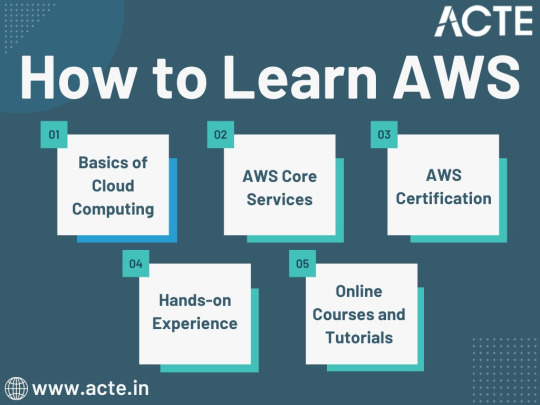
Amazon Web Services (AWS) represents an exciting frontier in the realm of cloud computing. As businesses and individuals increasingly rely on the cloud for innovation and scalability, AWS stands as a pivotal platform. The journey to AWS proficiency involves grasping fundamental cloud concepts, exploring core services, obtaining certifications, and acquiring practical experience. To expedite this process, online courses, tutorials, and structured training from renowned institutions like ACTE Technologies can be invaluable. ACTE Technologies' comprehensive AWS training programs provide hands-on experience, making your quest to master AWS more efficient and positioning you for a successful career in cloud technology.
8 notes
·
View notes
Text
AWS Solutions Architect Certification Journey: A Comprehensive Guide
Embarking on the path to becoming an AWS Certified Solutions Architect - Associate requires a meticulous and strategic approach. This extensive guide offers a step-by-step breakdown of essential steps to ensure effective preparation for this esteemed certification.
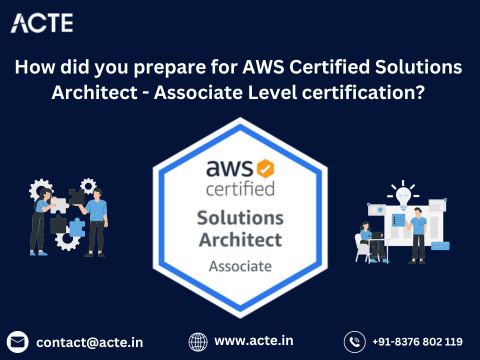
1. Grasp Exam Objectives: Initiate your preparation by thoroughly reviewing the official AWS Certified Solutions Architect - Associate exam guide. This roadmap outlines the key domains, concepts, and skills to be evaluated during the exam. A clear understanding of these objectives sets the tone for a focused and effective study plan.
2. Establish a Solid AWS Foundation: Build a robust understanding of core AWS services, infrastructure, and shared responsibility models. Dive into online courses, AWS documentation, and insightful whitepapers. Gain proficiency in essential services such as compute, storage, databases, and networking, laying the groundwork for success.
3. Hands-On Practicality: While theoretical knowledge is crucial, practical experience is where comprehension truly flourishes. Leverage the AWS Free Tier to engage in hands-on exercises. Execute tasks like instance management, security group configuration, S3 bucket setup, and application deployment. Practical experience not only reinforces theoretical knowledge but also provides valuable real-world insights.
4. Enroll in Online Learning Platforms: Capitalize on reputable online courses designed specifically for AWS Certified Solutions Architect preparation. Platforms like A Cloud Guru, Coursera, or the official AWS Training provide structured content, hands-on labs, and practice exams. These courses offer a guided learning path aligned with certification objectives, ensuring a comprehensive and effective preparation experience.
5. Delve into AWS Whitepapers: Uncover a wealth of knowledge in AWS whitepapers and documentation. Explore documents such as the Well-Architected Framework, AWS Best Practices, and Security Best Practices. These resources offer deep insights into architecting on AWS and come highly recommended in the official exam guide.
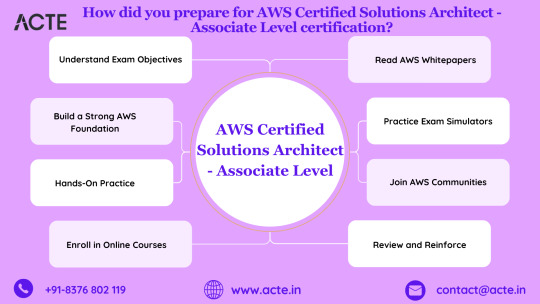
6. Embrace Practice Exam Simulators: Evaluate your knowledge and readiness through practice exams and simulators available on platforms like Whizlabs, Tutorials Dojo, or the official AWS practice exam. Simulated exam environments not only familiarize you with the exam format but also pinpoint areas that may require additional review.
7. Engage in AWS Communities: Immerse yourself in the AWS community. Participate in forums, discussion groups, and social media channels. Share experiences, seek advice, and learn from the collective wisdom of the community. This engagement provides valuable insights into real-world scenarios and enriches your overall preparation.
8. Regularly Review and Reinforce: Periodically revisit key concepts and domains. Reinforce your understanding through diverse methods like flashcards, summarization, or teaching concepts to others. An iterative review process ensures that knowledge is retained and solidified.
9. Effective Time Management: Develop a well-structured study schedule aligned with your commitments. Prioritize topics based on their weight in the exam guide and allocate ample time for hands-on practice. Efficient time management ensures a balanced and thorough preparation journey.
10. Final Preparation and Confidence Boost: As the exam approaches, conduct a final review of key concepts. Revisit practice exams to bolster confidence and ensure familiarity with the exam interface. Confirm your ease in navigating the AWS Management Console and understanding the exam format.
In conclusion, the journey to mastering AWS Certified Solutions Architect - Associate requires strategic planning and dedicated effort. Success is not merely about passing an exam but about acquiring practical skills applicable in real-world scenarios. Approach this preparation journey with commitment, practical engagement, and a mindset of continuous learning within the ever-evolving AWS ecosystem. By navigating this dynamic landscape, you are not just preparing for a certification; you are laying the foundation for a successful career as an AWS Solutions Architect.
2 notes
·
View notes
Text
Where to learn cloud computing for free ?
💡 Where to Learn Cloud Computing for Free? Your First Steps in 2025

So you’ve heard about cloud computing. Maybe you’ve seen the job titles—Cloud Engineer, DevOps Specialist, AWS Associate—or heard stories of people getting hired after just a few months of learning.
Naturally, you wonder: "Can I learn cloud computing for free?"
Yes, you can. But you need to know where to look, and what free learning can (and can’t) do for your career.
☁️ What Can You Learn for Free?
Free cloud resources help you understand:
What cloud computing is
How AWS, Azure, or GCP platforms work
Basic terminology: IaaS, SaaS, EC2, S3, VPC, IAM
Free-tier services (you can try cloud tools without being charged)
Entry-level certification concepts
🌐 Best Places to Learn Cloud for Free (Legit Sources)
✅ AWS Free Training & AWS Skill Builder
📍 https://aws.amazon.com/training
Learn cloud basics with self-paced videos
Good for AWS Cloud Practitioner prep
Access real AWS Console via the free tier
✅ Microsoft Learn – Azure
📍 https://learn.microsoft.com/en-us/training
Offers free Azure paths for beginners
Gamified learning experience
Ideal for preparing for AZ-900
✅ Google Cloud Skills Boost
📍 https://cloud.google.com/training
Interactive quests and labs
Learn Compute Engine, IAM, BigQuery
Some credits may be needed for advanced labs
✅ YouTube Channels
FreeCodeCamp: Full cloud crash courses
Simplilearn, Edureka, NareshIT: Basic tutorials
AWS, Azure official channels: Real demos
✅ GitHub Repos & Blogs
Open-source lab guides
Resume projects (e.g., deploy a website on AWS)
Real-world practice material
⚠️ But Wait—Here’s What Free Learning Misses
While free content is great to start, most learners eventually hit a wall:
❌ No structured syllabus
❌ No mentor to answer questions
❌ No feedback on real projects
❌ No resume guidance or placement support
❌ Certification confusion (what to take, when, why?)
That’s where formal, hands-on training can make the difference—especially if you want to get hired.
🎓 Want to Learn Faster, Smarter? Try NareshIT’s Cloud Courses
At NareshIT, we’ve helped over 100,000 learners start their cloud journey—with or without a tech background.
We bridge the gap between free concepts and job-ready skills.
🔹 AWS Cloud Beginner Program
Duration: 60 Days
Covers EC2, IAM, S3, Lambda
Includes: AWS Cloud Practitioner & Associate exam prep
Ideal For: Freshers, support engineers, and non-coders
🔹 Azure Fundamentals Course
Duration: 45 Days
Learn VMs, Azure AD, Blob Storage, and DevOps basics
Prepares you for AZ-900 and AZ-104 certifications
Best For: IT admins and .NET developers
🔹 Google Cloud (GCP) Basics
Duration: 30 Days
Practice labs + GCP Associate Cloud Engineer training
Perfect for: Python devs, data learners, AI enthusiasts
📅 View all cloud training batches at NareshIT
👣 Final Words: Start Free. Scale Smart.
If you’re serious about cloud, there’s no shame in starting with free videos or cloud tutorials. That’s how many great engineers begin.
But when you’re ready to:
Work on real projects
Earn certifications
Prepare for interviews
Get career guidance
Then it’s time to consider a guided course like the ones at NareshIT.
📌 Explore new batches →
0 notes
Text
Creating a Scalable Amazon EMR Cluster on AWS in Minutes

Minutes to Scalable EMR Cluster on AWS
AWS EMR cluster
Spark helps you easily build up an Amazon EMR cluster to process and analyse data. This page covers Plan and Configure, Manage, and Clean Up.
This detailed guide to cluster setup:
Amazon EMR Cluster Configuration
Spark is used to launch an example cluster and run a PySpark script in the course. You must complete the “Before you set up Amazon EMR” exercises before starting.
While functioning live, the sample cluster will incur small per-second charges under Amazon EMR pricing, which varies per location. To avoid further expenses, complete the tutorial’s final cleaning steps.
The setup procedure has numerous steps:
Amazon EMR Cluster and Data Resources Configuration
This initial stage prepares your application and input data, creates your data storage location, and starts the cluster.
Setting Up Amazon EMR Storage:
Amazon EMR supports several file systems, but this article uses EMRFS to store data in an S3 bucket. EMRFS reads and writes to Amazon S3 in Hadoop.
This lesson requires a specific S3 bucket. Follow the Amazon Simple Storage Service Console User Guide to create a bucket.
You must create the bucket in the same AWS region as your Amazon EMR cluster launch. Consider US West (Oregon) us-west-2.
Amazon EMR bucket and folder names are limited. Lowercase letters, numerals, periods (.), and hyphens (-) can be used, but bucket names cannot end in numbers and must be unique across AWS accounts.
The bucket output folder must be empty.
Small Amazon S3 files may incur modest costs, but if you’re within the AWS Free Tier consumption limitations, they may be free.
Create an Amazon EMR app using input data:
Standard preparation involves uploading an application and its input data to Amazon S3. Submit work with S3 locations.
The PySpark script examines 2006–2020 King County, Washington food business inspection data to identify the top ten restaurants with the most “Red” infractions. Sample rows of the dataset are presented.
Create a new file called health_violations.py and copy the source code to prepare the PySpark script. Next, add this file to your new S3 bucket. Uploading instructions are in Amazon Simple Storage Service’s Getting Started Guide.
Download and unzip the food_establishment_data.zip file, save the CSV file to your computer as food_establishment_data.csv, then upload it to the same S3 bucket to create the example input data. Again, see the Amazon Simple Storage Service Getting Started Guide for uploading instructions.
“Prepare input data for processing with Amazon EMR” explains EMR data configuration.
Create an Amazon EMR Cluster:
Apache Spark and the latest Amazon EMR release allow you to launch the example cluster after setting up storage and your application. This may be done with the AWS Management Console or CLI.
Console Launch:
Launch Amazon EMR after login into AWS Management Console.
Start with “EMR on EC2” > “Clusters” > “Create cluster”. Note the default options for “Release,” “Instance type,” “Number of instances,” and “Permissions”.
Enter a unique “Cluster name” without <, >, $, |, or `. Install Spark from “Applications” by selecting “Spark”. Note: Applications must be chosen before launching the cluster. Check “Cluster logs” to publish cluster-specific logs to Amazon S3. The default destination is s3://amzn-s3-demo-bucket/logs. Replace with S3 bucket. A new ‘logs’ subfolder is created for log files.
Select your two EC2 keys under “Security configuration and permissions”. For the instance profile, choose “EMR_DefaultRole” for Service and “EMR_EC2_DefaultRole” for IAM.
Choose “Create cluster”.
The cluster information page appears. As the EMR fills the cluster, its “Status” changes from “Starting” to “Running” to “Waiting”. Console view may require refreshing. Status switches to “Waiting” when cluster is ready to work.
AWS CLI’s aws emr create-default-roles command generates IAM default roles.
Create a Spark cluster with aws emr create-cluster. Name your EC2 key pair –name, set –instance-type, –instance-count, and –use-default-roles. The sample command’s Linux line continuation characters () may need Windows modifications.
Output will include ClusterId and ClusterArn. Remember your ClusterId for later.
Check your cluster status using aws emr describe-cluster –cluster-id myClusterId>.
The result shows the Status object with State. As EMR deployed the cluster, the State changed from STARTING to RUNNING to WAITING. When ready, operational, and up, the cluster becomes WAITING.
Open SSH Connections
Before connecting to your operating cluster via SSH, update your cluster security groups to enable incoming connections. Amazon EC2 security groups are virtual firewalls. At cluster startup, EMR created default security groups: ElasticMapReduce-slave for core and task nodes and ElasticMapReduce-master for main.
Console-based SSH authorisation:
Authorisation is needed to manage cluster VPC security groups.
Launch Amazon EMR after login into AWS Management Console.
Select the updateable cluster under “Clusters”. The “Properties” tab must be selected.
Choose “Networking” and “EC2 security groups (firewall)” from the “Properties” tab. Select the security group link under “Primary node”.
EC2 console is open. Select “Edit inbound rules” after choosing “Inbound rules”.
Find and delete any public access inbound rule (Type: SSH, Port: 22, Source: Custom 0.0.0.0/0). Warning: The ElasticMapReduce-master group’s pre-configured rule that allowed public access and limited traffic to reputable sources should be removed.
Scroll down and click “Add Rule”.
Choose “SSH” for “Type” to set Port Range to 22 and Protocol to TCP.
Enter “My IP” for “Source” or a range of “Custom” trustworthy client IP addresses. Remember that dynamic IPs may need updating. Select “Save.”
When you return to the EMR console, choose “Core and task nodes” and repeat these steps to provide SSH access to those nodes.
Connecting with AWS CLI:
SSH connections may be made using the AWS CLI on any operating system.
Use the command: AWS emr ssh –cluster-id –key-pair-file <~/mykeypair.key>. Replace with your ClusterId and the full path to your key pair file.
After connecting, visit /mnt/var/log/spark to examine master node Spark logs.
The next critical stage following cluster setup and access configuration is phased work submission.
#AmazonEMRcluster#EMRcluster#DataResources#SSHConnections#AmazonEC2#AWSCLI#technology#technews#technologynews#news#govindhtech
0 notes
Text
Integrate AWS S3 for File Handling in Django Applications: A Step-by-Step Guide
Integrating AWS S3 for File Handling in Django Applications 1. Introduction Integrating AWS S3 into a Django application enhances file handling capabilities by leveraging S3’s scalability, availability, and durability. This tutorial guides you through setting up AWS S3 for Django, covering setup, code implementation, best practices, and troubleshooting. What You’ll Learn: – Configure AWS S3…
0 notes
Text
Amazon Simple Storage Service Tutorial | AWS S3 Bucket Explained with Example for Cloud Developer
Full Video Link https://youtube.com/shorts/7xbakEXjvHQ Hi, a new #video on #aws #simplestorageservice #s3bucket #cloudstorage is published on #codeonedigest #youtube channel. @java #java #awscloud @awscloud #aws @AWSCloudIndia #Cloud #
Amazon Simple Storage Service (Amazon S3) is an object storage service that offers industry-leading scalability, data availability, security, and performance. Customers of all sizes and industries can use Amazon S3 to store and protect any amount of data. Amazon S3 provides management features so that you can optimize, organize, and configure access to your data to meet your specific business,…
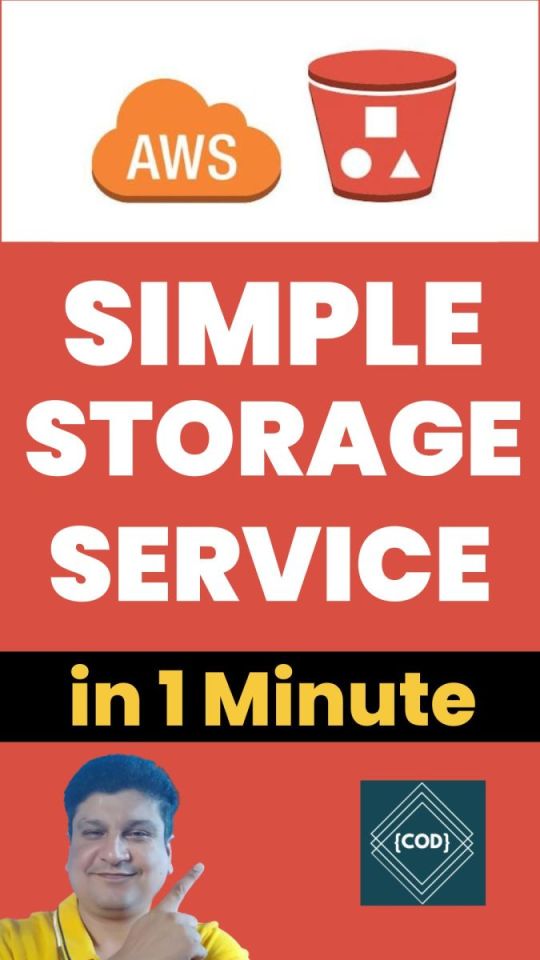
View On WordPress
#amazon s3#amazon s3 bucket#amazon s3 tutorial#amazon web services#aws#aws cloud#aws s3#aws s3 bucket#aws s3 bucket tutorial#aws s3 interview questions and answers#aws s3 object lock#aws s3 object lock governance mode#aws s3 object storage#aws s3 tutorial#aws storage services#cloud computing#s3 bucket#s3 bucket creation#s3 bucket in aws#s3 bucket policy#s3 bucket public access#s3 bucket tutorial#simple storage service (s3)
0 notes
Text
Getting Started with AWS: A Beginner’s Guide to Cloud Computing

In today’s digital-first world, cloud computing has transformed the way businesses and individuals operate. Amazon Web Services (AWS), a world leader in cloud solutions, is leading this change. For those just stepping into the world of technology or looking to boost their career, learning AWS is a great place to start. It’s a gateway to understanding cloud infrastructure, developing in-demand skills, and launching exciting projects.
What is AWS?
Amazon Web Services (AWS) is a cloud computing platform that offers over 200 fully featured services. These services cover computing, storage, databases, networking, analytics, artificial intelligence, security, and more. What sets AWS apart is its scalability and flexibility—users can easily increase or decrease resources as per their needs.
Why Should Beginners Learn AWS?
Learning AWS opens up numerous possibilities, both professionally and personally. Here's why it's worth your time:
High Demand Skills: AWS expertise is in high demand across industries, including finance, healthcare, retail, and IT.
Beginner-Friendly Learning Path: With the AWS Free Tier and tons of tutorials available, it's easier than ever to start learning.
Boosts Employability: Even basic AWS knowledge can make your resume stand out.
Supports Online Learning: Ideal for those seeking flexible and remote education opportunities.
Career Jumpstart: From freelancing to landing a job in cloud support or DevOps, AWS knowledge helps beginners start strong.
Essential AWS Services for Beginners
When getting started with AWS, focus on a few core services that provide a solid foundation:
Amazon EC2 (Elastic Compute Cloud): This service allows you to create and manage virtual servers, a fundamental part of many cloud applications.
Amazon S3 (Simple Storage Service): A highly scalable storage service used for backup, archiving, and big data analytics.
AWS Lambda: Lets you run code without managing servers, great for beginners learning about serverless architecture.
Amazon RDS (Relational Database Service): Makes database management easier by automating tasks like backups and scaling.
AWS IAM (Identity and Access Management): Essential for managing permissions and ensuring secure access to AWS resources.
How to Start Learning AWS
The beauty of AWS is that you can start learning today—no advanced degree or professional background required.
Sign Up for AWS Free Tier: It offers access to a range of services for free for 12 months. This is perfect for hands-on practice.
Enroll in Online Courses: Platforms like EasyShiksha.com offer structured courses that simplify AWS concepts for beginners.
Follow Tutorials and Guides: AWS itself offers learning paths, and so do many third-party educators.
Join Study Groups or Communities: Connect with others to ask questions, share resources, and stay motivated.
Participate in a Free Internship: Apply your skills in real-world projects by joining a free internship that focuses on AWS or cloud environments.
Benefits of AWS for Beginners
Learning AWS offers more than just technical know-how—it shapes your thinking and equips you with modern problem-solving skills.
Build and deploy real applications in a virtual environment
Understand modern DevOps workflows and automation
Learn about system design and cloud architecture
Access global resources and tools used by Fortune 500 companies
Unlock potential career paths in cloud support, DevOps, data engineering, and more
Participate in free internship programs to gain hands-on industry experience
Real-World Applications of AWS
AWS is not just for IT professionals—it’s everywhere. From startups building their first apps to enterprises running global operations, AWS powers it all.
Education: Schools and universities use AWS to deliver online courses, manage student data, and conduct virtual labs.
Healthcare: Secure patient records, data analytics, and telehealth platforms often run on AWS infrastructure.
E-commerce: Online stores host their websites, manage transactions, and scale customer support using AWS services.
Media & Entertainment: Video streaming platforms rely on AWS for content storage, delivery, and user engagement.
Conclusion
Cloud computing is the future, and AWS is a key to unlocking it. Whether you're a beginner exploring new tech skills, a student looking to enhance your resume, or someone seeking a career change, AWS offers a practical and accessible path forward. With tools, tutorials, and even free internship programs, AWS gives you the foundation to learn, grow, and succeed.
To get started with AWS learning and hands-on training, visit easyshiksha.com. EasyShiksha.com offers beginner-friendly online courses and career-boosting opportunities to help you take your first confident steps into the cloud.
0 notes
Text
AWS Certified Solutions Architect (SAA-C03): The Roadmap to Success
Introduction
The AWS Certified Solutions Architect – Associate (SAA-C03) certification is a valuable credential for IT professionals looking to validate their cloud computing expertise. This certification focuses on designing cost-effective, scalable, and secure solutions on the AWS platform. It is widely recognized in the industry and is ideal for those aiming to advance their careers in cloud architecture.

Who Should Take the SAA-C03 Exam?
This certification is designed for individuals who have experience working with AWS and want to enhance their cloud solution architecture skills. It is best suited for solutions architects, developers, DevOps engineers, IT consultants, and professionals who design and implement distributed systems on AWS.
Prerequisites for the Exam
Although there are no official prerequisites, AWS recommends at least one year of hands-on experience designing cloud solutions. Familiarity with AWS core services, networking, security, and best practices is beneficial. Candidates should also have a basic understanding of high-availability architectures and cost optimization strategies.
Exam Structure and Format
The SAA-C03 exam consists of multiple-choice and multiple-response questions. Candidates have 130 minutes to complete the exam, which costs $150. The exam can be taken online or at Pearson VUE testing centers. AWS does not disclose the exact passing score, but candidates should aim for at least 70%–75%.
Exam Domains and Topics
The exam is divided into four key domains:
1. Design Secure Architectures (30%)
This domain focuses on implementing AWS security best practices. Candidates should understand identity and access management (IAM), data encryption, and compliance frameworks.
2. Design Resilient Architectures (26%)
Candidates must demonstrate knowledge of high-availability and fault-tolerant systems. This includes using Auto Scaling, Load Balancers, and AWS services to ensure system reliability.
3. Design High-Performing Architectures (24%)
This section covers performance optimization, database selection, and choosing the right storage and networking solutions. It also includes caching strategies and content delivery networks (CDNs).
4. Design Cost-Optimized Architectures (20%)
This domain tests candidates on AWS cost management tools, pricing models, and methods for optimizing resource utilization to reduce costs.
Key AWS Services to Focus On
Understanding core AWS services is essential for passing the exam. Some important services include:
Compute: Amazon EC2, AWS Lambda, and Elastic Load Balancing.
Storage: Amazon S3, Amazon EBS, and Amazon Glacier.
Databases: Amazon RDS, Amazon DynamoDB, and Amazon Aurora.
Networking: VPC, Route 53, AWS CloudFront, and AWS Direct Connect.
Security: IAM, AWS KMS, AWS Shield, and AWS WAF.
Monitoring: Amazon CloudWatch, AWS Trusted Advisor, and AWS Cost Explorer.
Study Tips for the SAA-C03 Exam
1. Take AWS Official Training
AWS offers a variety of free and paid training courses to help candidates prepare. The AWS Skill Builder platform provides structured learning paths for certification preparation.
2. Gain Hands-On Experience
Practical knowledge is essential for understanding AWS services. Set up a free-tier AWS account and practice deploying and managing cloud resources.
3. Use Practice Exams
Taking mock tests helps candidates identify weak areas. Platforms like Udemy, Whizlabs, and Tutorials Dojo offer high-quality practice exams.
4. Join Study Groups and Online Communities
Engaging with AWS communities on LinkedIn, Reddit, and Discord can provide valuable insights and study resources.
5. Read AWS Whitepapers and Documentation
AWS provides whitepapers on best practices, security, and cost optimization. Reviewing these documents can improve understanding of key exam topics.
Career Benefits of the AWS SAA-C03 Certification
1. Higher Salary Potential
AWS-certified professionals earn competitive salaries, with average earnings exceeding $130,000 per year.
2. Industry Recognition
The certification is globally recognized and demonstrates expertise in cloud computing, making professionals more attractive to employers.
3. Expanded Job Opportunities
Holding this certification can open doors to roles such as AWS Solutions Architect, Cloud Engineer, and DevOps Engineer.
4. Enhanced Cloud Knowledge
The certification process helps candidates develop a deeper understanding of cloud architecture and AWS services.Learn More: AWS Certified Solutions Architect (SAA-C03)
0 notes
Text
Understanding the Role of an AWS Solutions Architect

What is an AWS Solutions Architect?
An AWS Solutions Architect designs cloud solutions that address business requirements and technical needs. The main responsibility is to architect secure, scalable cloud solutions using AWS resources such as EC2, S3, RDS, and Lambda. They architect cost-efficient AWS solutions according to business requirements and deploy the best security, performance, and high-availability patterns. Coordination is required as architects collaborate with developers, IT staff, and business stakeholders so that the cloud can be easily implemented. They also offer cloud migration consultancy, infrastructure optimization, and disaster recovery planning consultancy to enable companies to attain efficiency and reliability in the cloud.
Skills Required for an AWS Solutions Architect
An AWS Solutions Architect must possess knowledge of cloud computing concepts and AWS service knowledge to be successful in this position.
Vital skills such as knowledge of AWS services like IAM, VPC, Route 53, and Auto Scaling, security and networking skills like VPNs, encryption, and compliance are mandatory. Cost optimization is also a mandate since architects must get the maximum out of cloud spending with right-sizing and utilizing AWS cost optimizations. Problem-solving skills are also required to craft creative solutions to complex business challenges. Practical exposure of standing up and managing AWS resources is very valuable because it subjects architects to actual scenarios and best practices.
How to Become an AWS Solutions Architect
Theoretical education, practical application, and certification are necessary to become an AWS Solutions Architect.
First, learn the foundations of cloud computing and AWS core services. Hands-on experience with AWS Free Tier offers the future architects a chance to try out various AWS services and develop real-world projects. Online tutorials on platforms such as Udemy, A Cloud Guru, and AWS Training can offer detailed information and systematic learning. The second is obtaining the AWS Certified Solutions Architect – Associate certificate, which confirms the knowledge of an individual in designing cloud solutions. With more experience, one can upgrade to the AWS Certified Solutions Architect – Professional, which provides deeper insights into advanced cloud architectures and best practices.
Career Opportunities and Salary
Career prospects for AWS Solutions Architects are growing as cloud technology is increasingly being used by more businesses.
Companies in various sectors, from finance and health to online businesses, require specialists to operate their cloud infrastructure. It is one of the high-paying careers with bright futures, with the mean U.S. yearly wage at around $128,000, and for India, ₹8,00,000 to ₹15,00,000 per year. The salary will differ based on location, years of experience, and level of qualification, with specialists possessing higher-level qualification and years of work experience being able to command high-end pay. With the coming of cloud computing, the job title of an AWS Solutions Architect will be needed even more in the technological industry.
Conclusion
An AWS Solutions Architect has a very vital role to provide businesses with the ability to leverage the capabilities of AWS to develop scalable and fault-tolerant cloud solutions. With the appropriate qualifications, skills, and experience in the real world, the profession has enormous growth prospects in the ever-evolving cloud computing industry. New or seasoned IT professional, AWS Solutions Architect certification can unleash new and challenging professional prospects and gratifying career prospects in the cloud. AWS certifications and hands-on experience will make likely professionals achieve improved employability in high-end firms globally.
0 notes
Text
To get 100% on your first attempt at the Amazon CLF-C02 (AWS Certified Cloud Practitioner) exam, follow these steps:
1. Understand the Exam Structure
Domains Covered:
Cloud Concepts (24%)
Security and Compliance (30%)
Cloud Technology and Services (34%)
Billing, Pricing, and Support (12%)
Number of Questions: ~65 (Multiple-choice & Multiple-response)
Time Limit: 90 minutes
Passing Score: ~700/1000
2. Study the Right Resources
AWS Cloud Practitioner Essentials Course (Free on AWS Training)
AWS Whitepapers:
AWS Well-Architected Framework
AWS Pricing Overview
AWS Security Best Practices
AWS FAQs (for services like EC2, S3, IAM, RDS, etc.)
AWS Skill Builder (practice tests & labs)
3. Take Practice Exams
Use AWS Official Practice Tests and Udemy / Whizlabs / Tutorials Dojo practice questions.
Analyze mistakes and review weak topics.
4. Hands-On Experience
Create a Free AWS Account and practice:
Launching an EC2 instance
Creating an S3 bucket
Configuring IAM users, groups, and policies
Exploring AWS Billing Dashboard
5. Exam Strategy
Read questions carefully (watch for tricky wording).
Eliminate incorrect choices before selecting your answer.
Manage your time well (1.5 minutes per question).
Mark for review if unsure and revisit before submitting.
Clearcatnet is a great resource for preparing for the AWS Certified Cloud Practitioner (CLF-C02) exam. They provide:
High-quality practice questions that closely match the real exam Detailed explanations for each answer Updated content aligned with AWS exam objectives Exam simulations to help you get comfortable with the format
Using ClearCat along with AWS official resources, whitepapers, and hands-on practice will boost your chances of scoring 100% on your first attempt
1 note
·
View note
Text
Elevate Your Career With AWS: A In-depth Guide to Becoming an AWS Expert
In the fast-paced and ever-evolving realm of modern technology, proficiency in Amazon Web Services (AWS) has emerged as an invaluable asset, a passport to the boundless opportunities of the digital age. AWS, the colossal titan of cloud computing, offers an extensive array of services that have revolutionized the way businesses operate, innovate, and scale in today's interconnected world. However, mastering AWS is not a mere task; it is a journey that calls for a structured approach, hands-on experience, and access to a treasure trove of reputable learning resources.

Welcome to the world of AWS mastery, where innovation knows no bounds, where your skills become the catalyst for transformative change. Your journey begins now, as we set sail into the horizon of AWS excellence, ready to explore the limitless possibilities that await in the cloud.
Step 1: Setting Sail - Sign Up for AWS
Your AWS voyage begins with a simple yet crucial step - signing up for an AWS account. Fortunately, AWS offers the Free Tier, a generous offering that grants limited free access to many AWS services for the first 12 months. This enables you to explore AWS, experiment with its services, and learn without incurring costs.
Step 2: Unveiling the Map - Official AWS Documentation
Before you embark on your AWS adventure, it's essential to understand the lay of the land. AWS provides extensive documentation for all its services. This documentation is a treasure of knowledge, offering insights into each service, its use cases, and comprehensive guides on how to configure and utilize them. It's a valuable resource that is regularly updated to keep you informed about the latest developments.
Step 3: Guided Tours - Online Courses and Tutorials
While solo exploration is commendable, guided tours can significantly enhance your learning experience. Enroll in online courses and tutorials offered by reputable platforms such as Coursera, Udemy, ACTE, or AWS Training and Certification. These courses often include video lectures, hands-on labs, and quizzes to reinforce your understanding. Consider specialized AWS training programs like those offered by ACTE Technologies, where expert-led courses can take your AWS skills to the next level.
Step 4: Raising the Flag - AWS Certification
Achieving AWS certification is akin to hoisting your flag of expertise in the AWS realm. AWS offers a range of certifications that validate your proficiency in specific AWS areas, including Solutions Architect, Developer, SysOps Administrator, and more. Preparing for these certifications provides in-depth knowledge, and there are study guides and practice exams available to aid your preparation.
Step 5: Hands-on Deck - Practical Experience
In the world of AWS, knowledge is best acquired through hands-on experience. Create AWS accounts designated for practice purposes, set up virtual machines (EC2 instances), configure storage (S3), and experiment with various AWS services. Building real projects is an effective way to solidify your understanding and showcase your skills.
Step 6: Navigating the AWS Console and CLI
As you progress, it's essential to be fluent in navigating AWS. Familiarize yourself with the AWS Management Console, a web-based interface for managing AWS resources. Additionally, learn to wield the AWS Command Line Interface (CLI), a powerful tool for scripting and automating tasks, giving you the agility to manage AWS resources efficiently.
Step 7: Joining the Crew - Community Engagement
Learning is often more enriching when you're part of a community. Join AWS-related forums and communities, such as the AWS subreddit and AWS Developer Forums. Engaging with others who are on their own AWS learning journeys can help you get answers to your questions, share experiences, and gain valuable insights.
Step 8: Gathering Wisdom - Blogs and YouTube Channels
Stay updated with the latest trends and insights in the AWS ecosystem by following AWS blogs and YouTube channels. These platforms provide tutorials, case studies, and deep dives into AWS services. Don't miss out on AWS re:Invent sessions, available on YouTube, which offer in-depth explorations of AWS services and solutions.
Step 9: Real-World Adventures - Projects
Application of your AWS knowledge to practical projects is where your skills truly shine. Whether it's setting up a website, creating a scalable application, or orchestrating a complex migration to AWS, hands-on experience is invaluable. Real-world projects not only demonstrate your capabilities but also prepare you for the challenges you might encounter in a professional setting.
Step 10: Staying on Course - Continuous Learning
The AWS landscape is ever-evolving, with new services and features being introduced regularly. Stay informed by following AWS news, subscribing to newsletters, and attending AWS events and webinars. Continuous learning is the compass that keeps you on course in the dynamic world of AWS.
Step 11: Guiding Lights - Mentorship
If possible, seek out a mentor with AWS experience. Mentorship provides valuable guidance and insights as you learn. Learning from someone who has navigated the AWS waters can accelerate your progress and help you avoid common pitfalls.

Mastering AWS is not a destination; it's a continuous journey. As you gain proficiency, you can delve into advanced topics and specialize in areas that align with your career goals. The key to mastering AWS lies in a combination of self-study, hands-on practice, and access to reliable learning resources.
In conclusion, ACTE Technologies emerges as a trusted provider of IT training and certification programs, including specialized AWS training. Their expert-led courses and comprehensive curriculum make them an excellent choice for those looking to enhance their AWS skills. Whether you aim to propel your career or embark on a thrilling journey into the world of cloud computing, ACTE Technologies can be your steadfast partner on the path to AWS expertise.
AWS isn't just a skill; it's a transformative force in the world of technology. It's the catalyst for innovation, scalability, and boundless possibilities. So, set sail on your AWS journey, armed with knowledge, practice, and the determination to conquer the cloud. The world of AWS awaits your exploration.
9 notes
·
View notes
Text
AWS Mastery Unveiled: Your Step-by-Step Journey into Cloud Proficiency
In today's rapidly evolving tech landscape, mastering cloud computing is a strategic move for individuals and businesses alike. Amazon Web Services (AWS), as a leading cloud services provider, offers a myriad of tools and services to facilitate scalable and efficient computing. With AWS Training in Hyderabad, professionals can gain the skills and knowledge needed to harness the capabilities of AWS for diverse applications and industries. Whether you're a seasoned IT professional or a beginner eager to dive into the cloud, here's a step-by-step guide to learning and mastering Amazon AWS.
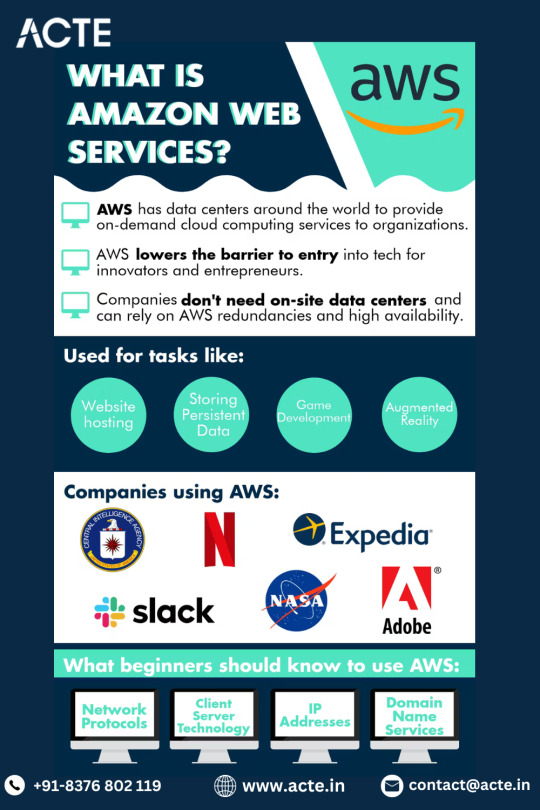
1. Start with AWS Documentation:
The foundation of your AWS journey begins with the official AWS documentation. This vast resource provides detailed information, tutorials, and guides for each AWS service. Take the time to familiarize yourself with the terminologies and fundamental concepts. Understanding the basics lays a solid groundwork for more advanced learning.
2. Enroll in AWS Training and Certification:
AWS provides a dedicated training and certification program to empower individuals with the skills required in today's cloud-centric environment. Explore the AWS Training and Certification portal, which offers a range of courses, both free and paid. Commence your AWS certification journey with the AWS Certified Cloud Practitioner, progressively advancing to specialized certifications aligned with your career goals.
3. Hands-On Practice with AWS Free Tier:
Theory is valuable, but hands-on experience is paramount. AWS Free Tier allows you to experiment with various services without incurring charges. Seize this opportunity to get practical, testing different services and scenarios. This interactive approach reinforces theoretical knowledge and builds your confidence in navigating the AWS console.
4. Explore Online Courses and Tutorials:
Several online platforms offer structured AWS courses. Websites like Coursera, Udemy, and A Cloud Guru provide video lectures, hands-on labs, and real-world projects. These courses cover a spectrum of topics, from foundational AWS concepts to specialized domains like AWS security and machine learning. To master the intricacies of AWS and unlock its full potential, individuals can benefit from enrolling in the Top AWS Training Institute. This training ensures that professionals gain the expertise needed to navigate the complexities of AWS, empowering them to contribute effectively to their organizations' digital transformation and success.
5. Build Projects and Apply Knowledge:
The true test of your AWS proficiency lies in applying your knowledge to real-world projects. Start small, perhaps by deploying a static website on Amazon S3. As you gain confidence, move on to more complex projects, such as configuring a virtual server on Amazon EC2 or creating a serverless application using AWS Lambda. Practical application solidifies your understanding and hones your problem-solving skills.
6. Join AWS Communities and Forums:
Learning is a collaborative effort. Joining AWS communities and forums allows you to connect with like-minded individuals, seek advice, and share your experiences. Platforms like the AWS Developer Forums provide a space for discussing challenges and learning from others' insights. Networking within the AWS community can open doors to valuable opportunities and collaborations.
7. Read AWS Whitepapers and Case Studies:
AWS regularly publishes whitepapers covering best practices, architecture recommendations, and real-world case studies. Delve into these resources to gain deeper insights into how AWS services are applied in diverse scenarios. Whitepapers provide a wealth of knowledge on topics such as security, scalability, and cost optimization.
8. Experiment with AWS CLI and SDKs:
Command Line Interface (CLI) proficiency is a valuable skill for any AWS practitioner. Familiarize yourself with the AWS CLI, as well as Software Development Kits (SDKs) for your preferred programming languages. Automating tasks through the CLI and integrating AWS services into your applications enhances efficiency and allows for more sophisticated configurations.
9. Attend AWS Events and Webinars:
Stay abreast of the latest AWS trends, updates, and best practices by attending AWS events, webinars, and conferences. These platforms often feature expert speakers, product announcements, and in-depth discussions on specific AWS topics. Engaging with industry leaders and experts provides valuable insights into the current state and future direction of AWS.
10. Stay Updated and Adapt:
The cloud computing landscape is dynamic, with AWS continually introducing new services and updates. Subscribe to AWS newsletters, follow AWS blogs, and listen to AWS-focused podcasts to stay informed about the latest developments. Continuous learning is key to adapting to the evolving cloud technology landscape.

In conclusion, mastering Amazon AWS is a journey that combines theoretical understanding, hands-on experience, and active participation in the AWS community. By following these ten steps, you can develop a comprehensive skill set that empowers you to leverage AWS effectively, whether you're building applications, optimizing processes, or advancing your career in the cloud.
2 notes
·
View notes